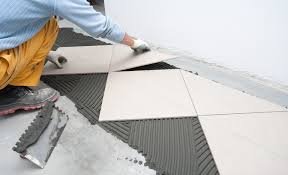Laying tile can seem like a straightforward project—spread some adhesive, place the tiles, and voilà! But in reality, tile installation is a highly detailed process that requires precision and care. Even minor mistakes can lead to costly repairs, wasted materials, or an unsatisfactory finish. Whether you’re tackling a kitchen backsplash or tiling an entire bathroom, avoiding common pitfalls is key to achieving a flawless result.
In this guide, we’ll cover the top 10 mistakes to avoid when laying tile and how careful planning and attention to detail can make all the difference.
1. Skipping Surface Preparation
One of the biggest mistakes people make when laying tile is neglecting to properly prepare the surface. Uneven or dirty surfaces can cause tiles to sit incorrectly, leading to uneven lines, lippage (when one tile’s edge is higher than the adjacent tile), or tiles that don’t adhere properly.
- What to do instead: Always ensure the surface is clean, level, and free of debris before you begin tiling. If you’re working with a concrete subfloor, it may need to be smoothed with a self-leveling compound. For walls, make sure old adhesive, paint, or any irregularities are removed.
2. Choosing the Wrong Adhesive
Not all tile adhesives (thinset, mastic, or mortar) are created equal. Using the wrong type for your project can result in tiles that don’t stick or a surface that doesn’t withstand moisture, heat, or foot traffic. For example, mastic should not be used for floor tiles, and not all adhesives are suitable for areas with high moisture.
- What to do instead: Select the appropriate adhesive for both the type of tile and the surface you’re working with. For wet areas like bathrooms or outdoor installations, use a waterproof thinset mortar. Check the tile manufacturer’s recommendations for the best match.
3. Incorrect Tile Layout and Planning
Jumping into a tiling project without a proper layout plan is a recipe for disaster. Poor planning can lead to awkward cuts, uneven grout lines, or unattractive tile placements. For example, you may end up with slivers of tiles on one side of the room or an off-center focal point.
- What to do instead: Take the time to measure your space accurately and create a layout plan. Dry-lay the tiles before applying adhesive to visualize how they’ll fit, and adjust the layout to avoid small tile cuts in visible areas. A symmetrical design around focal points (like a window or shower niche) will give your installation a professional look.
4. Using the Wrong Tile for the Space
Not all tiles are suitable for every environment. Choosing the wrong type of tile for a particular space can lead to issues with durability, safety, or appearance. For example, polished tiles may look beautiful in a bathroom, but they can be dangerously slippery when wet.
- What to do instead: Consider the room’s function and how it will affect your choice of tile. For bathrooms and kitchens, use slip-resistant tiles with a textured or matte finish. In high-traffic areas, opt for durable materials like porcelain, which can withstand wear and tear.
5. Neglecting Expansion Joints
Tiles expand and contract with changes in temperature and humidity. Without proper expansion joints, this movement can cause tiles to crack or pop loose. Failing to leave a gap around the edges of the room or not incorporating expansion joints can lead to problems down the road.
- What to do instead: Always leave a small gap (typically 1/8″ to 1/4″) between the tiles and the walls, cabinets, or other structures. These expansion joints allow the tile to shift slightly without cracking. Use caulk, not grout, in these joints to allow for flexibility.
6. Incorrect Grout Application
Grout may seem like a finishing touch, but it plays a critical role in the durability and appearance of your tile installation. Applying too much grout, not cleaning the grout lines properly, or choosing the wrong grout for your tile type can lead to discoloration, cracking, or weak joints.
- What to do instead: Choose a grout that complements your tile in both color and type. Epoxy grout, for example, is more durable and stain-resistant but requires a bit more skill to apply. After spreading the grout, wipe away excess before it hardens, and seal the grout if recommended by the manufacturer to prevent stains and moisture damage.
7. Not Using Spacers for Consistent Grout Lines
Consistent grout lines are essential for a polished, professional finish. Eyeballing the spacing between tiles without the help of spacers often leads to uneven gaps and a chaotic look. It can also cause tiles to shift during installation, resulting in misalignment.
- What to do instead: Always use spacers between tiles to ensure uniform grout lines. Spacers come in various sizes, so choose one that suits your design, whether you prefer narrow or wide grout lines. Remove the spacers once the adhesive has set but before grouting.
8. Forgetting to Account for Tile Cuts
Many DIY tile installations run into trouble when it comes to cutting tiles. Whether it’s around corners, outlets, or odd angles, poorly cut tiles can ruin the entire look of the project. Rushing through cuts or not using the right tools can result in uneven edges, broken tiles, or wasted material.
- What to do instead: Invest in the right tile-cutting tools, such as a wet saw or tile nippers, depending on the type of tile you’re using. Take your time to measure carefully before making any cuts, and practice on a spare tile if you’re new to using the tools.
9. Improper Trowel Use
The trowel is a key tool in tile installation, and using the wrong size or technique can lead to poor adhesion. If the adhesive is not spread evenly, or the trowel’s notch size doesn’t match the tile size, the tiles may not bond properly, leading to hollow spots or tiles lifting over time.
- What to do instead: Use the correct trowel size for your tile. Larger tiles require deeper notches to ensure full coverage of adhesive, while smaller tiles need smaller notches. Apply the adhesive at a consistent angle, and press the tiles firmly into place, ensuring there are no air pockets.
10. Rushing the Drying and Curing Process
One of the most common mistakes is rushing the project to completion. Whether it’s walking on the tiles too soon, grouting before the adhesive has fully cured, or applying sealant too early, impatience can undo all the hard work that’s been put into the project.
- What to do instead: Follow the manufacturer’s recommended drying and curing times for both adhesive and grout. Typically, you should wait at least 24 to 48 hours before walking on newly laid tiles or grouting. Sealing should only be done after the grout has fully cured, which can take several days.
Conclusion
Laying tile is a task that requires precision, patience, and a keen eye for detail. While it can be tempting to jump in and get started, taking the time to plan, prepare, and execute your tile installation correctly will save you from costly mistakes and unseat your tiling project with confidence, knowing what to watch out for along the way.


